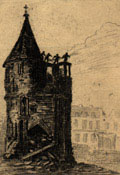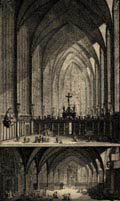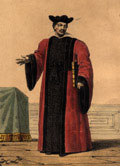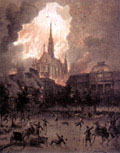Cite - Palais de Justice
The history of the law courts, located on the Ile de la Cite, is often intertwined with the city's history.
It is also closely linked to the history of the royal family, since the building was the home of the ruling families for a long time. A monarch by divine rights, the king's authority encompassed legislative and executive power but also judiciary authority. Little is known about the history of the law courts building until the Xth century. This is easily explained by the fact that the Merovingian and Carolingian kings and their court did not have a fixed residence. They may have on occasion resided on the Ile de la Cite.
The Palace: from Robert II dubbed "The Pious" to Charles V
The first Capetians, with Robert II The Pious (996-1031), had the royal palace built as a symbol of sovereignty.
 |
| The Montgomery tower |
The king's residence is located in the eleventh chamber of the Appeal Court, between the first chamber of the court and the entrance to the Supreme Court of Appeal. The royal residence includes a rectangular central building, flanked on each side by a square tower. The tower on the right houses the king's courtyard, on the first floor. The central building has four rooms on the ground floor for the queen and four rooms on the piano nobile for the king.
A spiral staircase connects the chambers of the king and queen. This staircase was later used for transferring prisoners from the Conciergerie to the Parlement Hall.
After 1111, King Louis VI, called "The Fat", ordered the construction of the royal dungeon in the courtyard behind the king's residence. This dungeon is known by the name of "Grosse Tour" (it was later called the "Tour Montgomery": Montgomery was imprisoned and perhaps even executed there).
Philip Augustus was born in the palace in 1165. He was christened in the Chapelle Saint-Michel (the chapel was located on the site of the present public entrance).
During the reign of Philip Augustus, the name of "Parlement" was given to the king's private council. Also during his reign, the functions of bailiff and provost were created, and the University of Paris was founded.
The Reign of Saint-Louis
 |
| The Sainte-Chapelle (upper chamber, lower chamber) |
Louis IX, dubbed "Saint-Louis", lived in the king's residence. He spent his wedding night praying in the King's chamber. He undertook several additions to the building: the Sainte-Chapelle, the Tresor des Chartes, the Chambre des Plaids, the Hall on the Water and the Bonbec tower.
The Sainte-Chapelle was built to house the Crown of Thorns. It housed religious relics. Further to a deal struck with Baldwin II, Latin emperor of Constantinople, Louis IX bought the relics that the Byzantine emperors kept at the sacred chapel of Boucoleon palace.
The Tresor des Chartes, a Gothic building adjoining the north side of the Sainte-Chapelle, has three floors. The first two serve as a vestry to the lower and higher chapels. The third floor is assigned to the library and the royal archives. It is the ancestor of the National Library.
A gallery, where the current Prisoner's Gallery and Merchant's Gallery are located, gave the king direct access to the higher chapel directly from his chambers. Access to the king's residence gained via a brass door that opens at the bottom of a 45-step staircase.
The New Palace under Philip IV (the Fair)
Philip IV (1285- 1314) commissioned Enguerrand de Marigny to rebuild the palace. The wall of the Cite was moved. Several buildings that stand either outside of the walls or between the wall and the palace were expropriated. The king's residence was remodeled. The Great Hall (the lobby) also called "prosecutor's room" or "Parlement hall", is the seat of Justice where the king holds the "Beds of Justice".
 |
| A counselor of the Parlement of Paris |
Philip IV created the position of "concierge", the guardian and keeper of the palace, for which the Conciergerie was erected. The Hall of the Men-at-Arms was built: it served as a mess room for the 3,000 people who formed the guard and the civil staff of the palace. The "concierge" was authorized to lease out space in the palace to tradesmen (which is the origin of the Haberdasher's Gallery).
The Parlement is where judicial cases were debated. It was made up basically of law technicians, qualified magistri (magistrates, lawyers).
Within the framework of executive justice, the Parlement was the highest authority, essentially an appeal instance. Up until the creation of the provincial Parlements, the king's court, seated in the palace on the Ile de la Cite, was the only real court of appeal in France.
- "In a room, on raised chairs on each side, are seated almost each day the men of State. They are named according to their function: some are masters in chambers, others are king's notaries. All, according to their station, obeying the orders of the king, work for the prosperity of the realm. By them are presented the petitions weighed with the scales of the most sincere equity. In a Grand-Salle, difficult cases are treated, they require the utmost tranquility and most complete retreat. Seated on their tribunal, men of the keenest ability, the masters of Parlement. With their infallible knowledge of the law and customs, they discuss the causes with full maturity and indulgence, hurl thunderbolts, and render definitive sentences."
(Excerpt from a eulogy written by John of Jandun in 1323.)
On the side of the defense, there are then around fifty lawyers.
The other chambers of parliament (petition chamber, investigation chamber, criminal chamber) played a secondary role.
Charles V leaves the Palace
 |
| Etienne Marcel Protects the Regent |
The walls of the palace witnessed a succession of kings up until Charles V, heir to the throne. On February 22, 1358, insurgents in Paris, under Etienne Marcel, the provost of merchants, penetrated into the chamber of the Dauphin, future King Charles V, then regent of France in the absence of his father, John The Good, who was being held captive in England. The king's counselors, Jean de Conflans and Robert Clermont, had their throats cut before the Dauphin's eyes in the Merchant's Gallery, their blood spattering onto the regent as the provost placed the hood bearing the red and blue colors of Paris on his head.
When Charles V was once more in control of the situation, he moved out of the palace, which held too many unpleasant memories, and henceforward took residences in the Louvre, the Hotel Saint-Pol or Vincennes, outside of Paris. Around 1370, Charles V had Paris's first public clock installed on the Clock Tower. In 1378, he received his uncle, Emperor Charles IV of Luxembourg in the Great Chamber. (The gown that the president of the Supreme Court of Appeal wears is the ceremonial dress worn by the king. It has remained essentially the same for more than one thousand years).
The Palace: from the Ancien Regime to the Revolution
The Parlement of Paris was the first supreme court of justice of the kingdom. Originally, the king appointed its members. But Francis I, short of money, sold the titles to replenish his resources. From then on, they were considered the property of their owners, and were passed on to the heirs.
Entitled to a seat in Parlement, by right or by privilege, were the noble figures of the realm: royal princes, the peers of France. When they rose up against the Crown, refusing to transcribe the royal edicts in their records, the sovereign resorted to the Bed of Justice, a formal session held in his presence. Exile to the provinces or prison were sometimes necessary. In the Great Chamber, directed by the presidents and counselors, the trials provided a living to a large number of nobles of the robe: prosecutors, lawyers, bailiffs, clerks, masters of pettifoggery and of procedure evoked by Racine in "Les Plaideurs". Since the XIVth century, the elected chief of advocates carries the magisterial staff of the Confraternity of Saint-Nicolas, which is why he is called the staff bearer.
Several fires ravaged the palace. On the night of March 6, 1618, a fire raced through the shops, and in less than one hour consumed the ornaments of the chambers, the sculptures, ceilings, doors, the royal statues in the lobby, the archives and all manner of pieces of evidence. Only a few records of little consequence were saved from the blaze by a bailiff of the name of Voisin, who fortunately was also able to turn the flames away from the Clock Tower. The spire of the Sainte-Chapelle burned down in 1630. (Around this time, the Dauphine Gallery was built adjacent to the west side of the Great Hall, to house merchants. It now contains the long "Louis XVI" staircase, which provides access to the Merchant Gallery from the inside.) There was a fire in the Court of Auditors in 1737, and in the Merchant Gallery in 1776. In the May Courtyard, some of the sentences rendered by Parlement were carried out: the Comtesse de la Motte, after the Affair of the Necklace (1786), was sentenced to be flogged at the foot of the staircase of the May Courtyard.
 |
| Rebuilding of the Palace after the Fire of 1776 |
In 1788, the Parlement convened the Estates General. An unfortunate decision: the Constituent Assembly pronounced its suppression. The Constituent restructured the tribunals by decree on September 7, 1790, and abolished all those existing under the authority of "viguiers" (provosts in the south of France), lords, provosts, viscounts, seneschals, bailiffs, and also those held in small castle-forts, bailiwick appeal courts, the provincial council of Artois, and those under the title of superior council and "parlement". On October 15, 1790, Bailly, the mayor of Paris, affixed the seals on the archives of the Parlement of Paris, which were then transported to the archives of France. Several members of Parlement were sent to the guillotine by the Convention.
The Palace: Seat of the Revolutionary Tribunal
 |
| Fouquier-Tinville judged by the Revolutionary Tribunal |
The tribunal, created by the Convention, was allocated the most prestigious rooms in the history of the Parlement of Paris: the Great Hall and the Saint-Louis Hall, renamed "chambre de la Liberte" and "chambre de l'Egalite". Fouquier-Tinville was put in charge of drawing up the indictments. The public prosecutor had a tied apartment set up at Quai de l'Horloge, adjacent to the Bonbec Tower, where he could be closer to his victims to prepare the cases and accelerate the already precipitous proceedings. Between April 1793 and July 1794, the Revolutionary Tribunal ordered the execution by guillotine of 2,600 people.
Marie-Antoinette was sentenced to die on October 16, 1793. She was guillotined on the Revolution Square. Danton was sentenced to death by the very tribunal that he helped to create. Robespierre was also sentenced to death. In 1795, the members of the tribunal and its public prosecutor, Fouquier-Tinville, were condemned by the same jurisdiction that they lead.
The Palace: from 1800 to our Time
 |
| The Law Courts and the Sainte-Chapelle |
The Revolution toppled the judicial organization. The new tribunals set up camp in the old building. Shortly after the coup, Napoleon ordered the architect Giraud to direct the indispensable repairs.
The judicial organization was restructured. Legal principles were modified: the hearing of infractions (crimes and torts) were entrusted to magistrates.
Under Napoleon's reign, the judges were appointed by the government in power. In 1804, Napoleon restored the title of "court". The "tribunals of appeal" and the "supreme tribunal of appeal" became the "court of appeal" and "supreme court of appeal". These courts rendered "judgements" and their judges wore the title of "councilor".
The Law Society was restored in 1810. In 1826 in the lobby, a statue was erected of Chretien Guillaume de Malesherbes (1721-1794), the only defender of Louis XVI who was not guillotined. The statue of French advocate, orator and statesman Pierre-Antoine Berryer (1790-1868) was erected in 1879, in front of the first, next to the Counsel Room (salle des referes). In 1840, the plans drawn up by Jean-Nicolas Huyot for the restructuring, renovation and extension of the palace were adopted by the municipal council.
Duc replaced Huyot after the latter's death. The new buildings of the Quai de l'Horloge and the entryway of the May Courtyard were erected between 1853 and 1857.
The vaults of the lobby were restored in 1858, and in 1859, the Caesar Tower (which was named for the Roman vestiges which it is believed to have succeeded), the Silver Tower (during the reign of Saint Louis, the royal treasury is said to have been kept in this tower) and the Bonbec Tower (where prisoners were tortured to loosen their tongue, with instruments designed to obtain... a "bon bec" -- a French expression akin to the English "sing like a canary" -- and produce the right answers). For four years, carpenters and masons transformed the old premises of the Dauphine Gallery to install the Attorney's Chamber. The Assize Court, the Auction Chamber and the lawyers library were constructed. The Supreme Court of Appeal was inaugurated in 1865. The redecoration of the Great Chamber (currently the first chamber of the high court of justice) in Louis XII style was undertaken in 1866. The king's residence, with its two square towers and buttresses dating from the XIth century, was torn down in 1868.
The Palace from 1870 to 1914
 |
| The Fire of 1871 |
The work undertaken under Baron Haussmann was completed, and the war of 1870 broke out. During the Commune, the insurgents set fires and on the night of May 24, 1871, the palace was set ablaze. Part of the palace was destroyed: the section that housed the court of first instance, the police, the civil registry, the archives, the rooms of the prosecutor general and the prosecutor of the Republic, the offices of the magistrates, the two rooms of the Assize Court built only two years prior, a large part of the Supreme Court of Appeal, the court of appeal, the lobby and the Great Chamber. The palace was rebuilt under the Third Republic. The Appeal Court of Paris was moved to premises built on the Quai des Orfevres and in the courtyard of the Sainte-Chapelle. In 1875, the Harlay Hall and its staircase on the Place Dauphine was inaugurated.
The premises of the judicial police and the criminal courts were completed in 1914.